Σύνδεση
Αναζήτηση
Πρόσφατα Θέματα
Παρόντες χρήστες
3 χρήστες είναι συνδεδεμένοι αυτήν την στιγμή:: 0 μέλη, 0 μη ορατοί και 3 επισκέπτες Κανένας
Περισσότεροι χρήστες υπό σύνδεση 28, στις Τετ Ιαν 25, 2017 1:10 am
Clock
Astronomy Picture of the Day
Σελίδα 8 από 15
Σελίδα 8 από 15 •  1 ... 5 ... 7, 8, 9 ... 11 ... 15
1 ... 5 ... 7, 8, 9 ... 11 ... 15 
 2017 June 11
2017 June 11
2017 June 11

IC 418: The Spirograph Nebula
Image Credit: NASA, ESA, and the Hubble Heritage Team (STScI/AURA); Acknowledgement: R. Sahai (JPL) et al.
Explanation: What is creating the strange texture of IC 418? Dubbed the Spirograph Nebula for its resemblance to drawings from a cyclical drawing tool, planetary nebula IC 418 shows patterns that are not well understood. Perhaps they are related to chaotic winds from the variable central star, which changes brightness unpredictably in just a few hours. By contrast, evidence indicates that only a few million years ago, IC 418 was probably a well-understood star similar to our Sun. Only a few thousand years ago, IC 418 was probably a common red giant star. Since running out of nuclear fuel, though, the outer envelope has begun expanding outward leaving a hot remnant core destined to become a white-dwarf star, visible in the image center. The light from the central core excites surrounding atoms in the nebula causing them to glow. IC 418 lies about 2000 light-years away and spans 0.3 light-years across. This false-color image taken from the Hubble Space Telescope reveals the unusual details.

IC 418: The Spirograph Nebula
Image Credit: NASA, ESA, and the Hubble Heritage Team (STScI/AURA); Acknowledgement: R. Sahai (JPL) et al.
Explanation: What is creating the strange texture of IC 418? Dubbed the Spirograph Nebula for its resemblance to drawings from a cyclical drawing tool, planetary nebula IC 418 shows patterns that are not well understood. Perhaps they are related to chaotic winds from the variable central star, which changes brightness unpredictably in just a few hours. By contrast, evidence indicates that only a few million years ago, IC 418 was probably a well-understood star similar to our Sun. Only a few thousand years ago, IC 418 was probably a common red giant star. Since running out of nuclear fuel, though, the outer envelope has begun expanding outward leaving a hot remnant core destined to become a white-dwarf star, visible in the image center. The light from the central core excites surrounding atoms in the nebula causing them to glow. IC 418 lies about 2000 light-years away and spans 0.3 light-years across. This false-color image taken from the Hubble Space Telescope reveals the unusual details.

panosol- Αριθμός μηνυμάτων : 762
Points : 927
Reputation : 15
Ημερομηνία εγγραφής : 17/06/2012
Ηλικία : 56
 2017 June 12
2017 June 12
2017 June 12
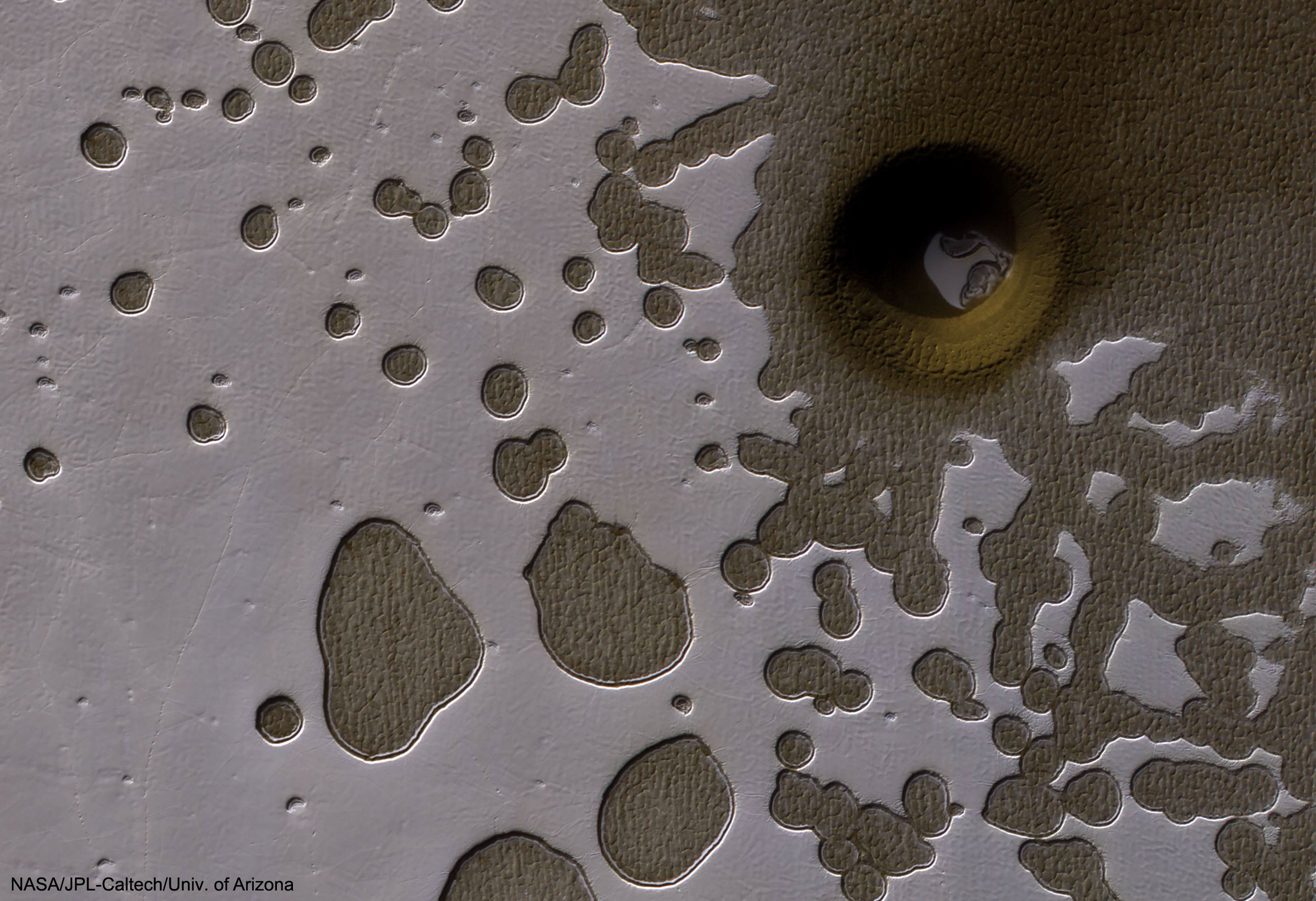
An Unusual Hole in Mars
Image Credit: NASA, MRO, HiRISE, JPL, U. Arizona
Explanation: What created this unusual hole in Mars? Actually, there are numerous holes pictured in this Swiss cheese-like landscape, with all-but-one of them showing a dusty, dark, Martian terrain beneath evaporating, light, carbon-dioxide ice. The most unusual hole is on the upper right, spans about 100-meters, and seems to punch through to a lower level. Why this hole exists and why it is surrounded by a circular crater remains a topic of speculation, although a leading hypothesis is that it was created by a meteor impact. Holes such as this are of particular interest because they might be portals to lower levels that extend into expansive underground caves. If so, these naturally-occurring tunnels are relatively protected from the harsh surface of Mars, making them relatively good candidates to contain Martian life. These pits are therefore prime targets for possible future spacecraft, robots, and even human interplanetary explorers.

An Unusual Hole in Mars
Image Credit: NASA, MRO, HiRISE, JPL, U. Arizona
Explanation: What created this unusual hole in Mars? Actually, there are numerous holes pictured in this Swiss cheese-like landscape, with all-but-one of them showing a dusty, dark, Martian terrain beneath evaporating, light, carbon-dioxide ice. The most unusual hole is on the upper right, spans about 100-meters, and seems to punch through to a lower level. Why this hole exists and why it is surrounded by a circular crater remains a topic of speculation, although a leading hypothesis is that it was created by a meteor impact. Holes such as this are of particular interest because they might be portals to lower levels that extend into expansive underground caves. If so, these naturally-occurring tunnels are relatively protected from the harsh surface of Mars, making them relatively good candidates to contain Martian life. These pits are therefore prime targets for possible future spacecraft, robots, and even human interplanetary explorers.

panosol- Αριθμός μηνυμάτων : 762
Points : 927
Reputation : 15
Ημερομηνία εγγραφής : 17/06/2012
Ηλικία : 56
 2017 June 13
2017 June 13
2017 June 13
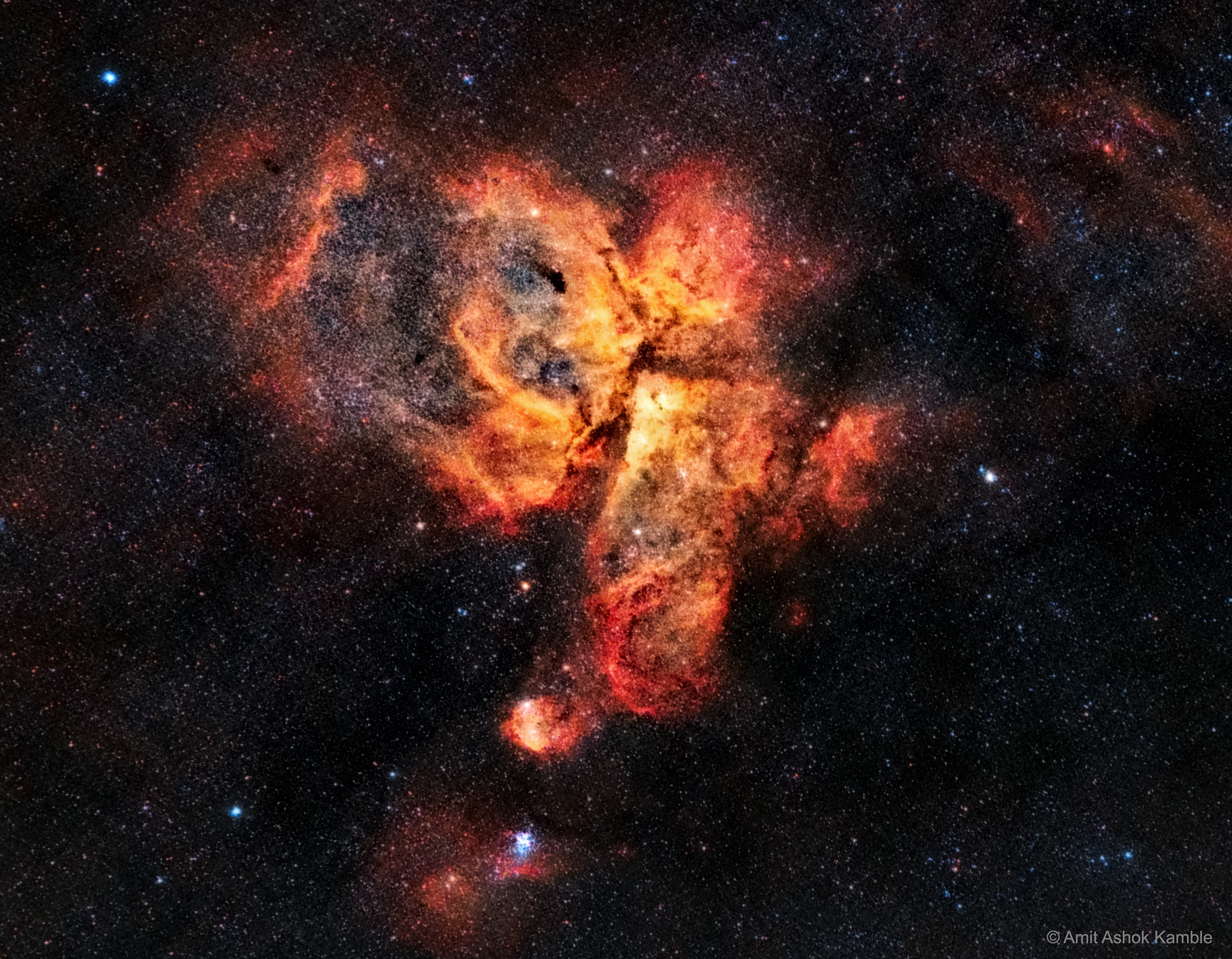
The Great Nebula in Carina
Image Credit & Copyright: Amit Ashok Kamble
Explanation: In one of the brightest parts of Milky Way lies a nebula where some of the oddest things occur. NGC 3372, known as the Great Nebula in Carina, is home to massive stars and changing nebulas. The Keyhole Nebula (NGC 3324), the bright structure just to the right of the image center, houses several of these massive stars and has itself changed its appearance. The entire Carina Nebula, captured here, spans over 300 light years and lies about 7,500 light-years away in the constellation of Carina. Eta Carinae, the most energetic star in the nebula, was one of the brightest stars in the sky in the 1830s, but then faded dramatically. While Eta Carinae itself maybe on the verge of a supernova explosion, X-ray images indicate that much of the Great Nebula in Carina has been a veritable supernova factory.

The Great Nebula in Carina
Image Credit & Copyright: Amit Ashok Kamble
Explanation: In one of the brightest parts of Milky Way lies a nebula where some of the oddest things occur. NGC 3372, known as the Great Nebula in Carina, is home to massive stars and changing nebulas. The Keyhole Nebula (NGC 3324), the bright structure just to the right of the image center, houses several of these massive stars and has itself changed its appearance. The entire Carina Nebula, captured here, spans over 300 light years and lies about 7,500 light-years away in the constellation of Carina. Eta Carinae, the most energetic star in the nebula, was one of the brightest stars in the sky in the 1830s, but then faded dramatically. While Eta Carinae itself maybe on the verge of a supernova explosion, X-ray images indicate that much of the Great Nebula in Carina has been a veritable supernova factory.

panosol- Αριθμός μηνυμάτων : 762
Points : 927
Reputation : 15
Ημερομηνία εγγραφής : 17/06/2012
Ηλικία : 56
 2017 June 14
2017 June 14
2017 June 14
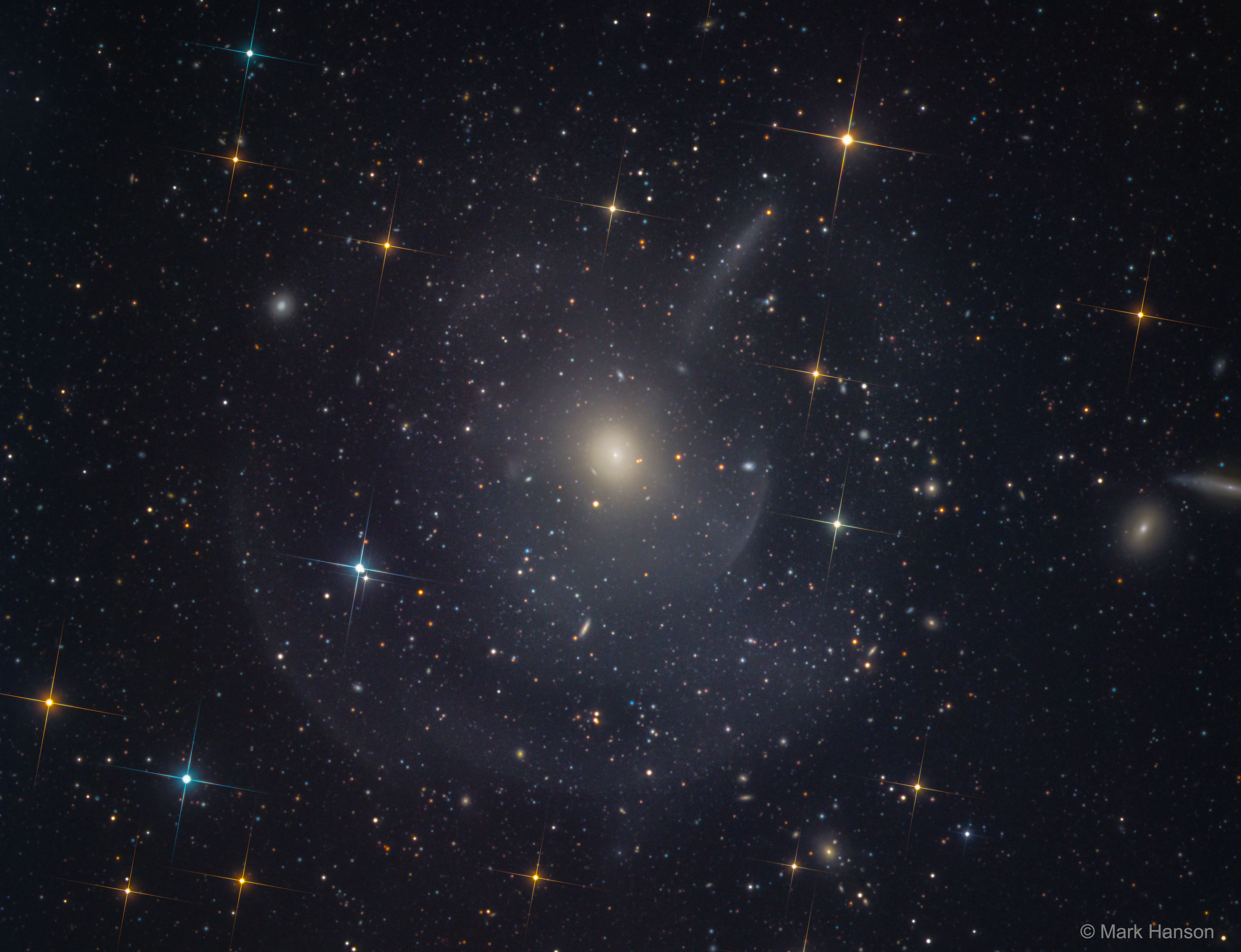
M89: Elliptical Galaxy with Outer Shells and Plumes
Image Credit & Copyright: Mark Hanson
Explanation: Can you see them? This famous Messier object M89, a seemingly simple elliptical galaxy, is surrounded by faint shells and plumes. The cause of the shells is currently unknown, but possibly tidal tails related to debris left over from absorbing numerous small galaxies in the past billion years. Alternatively the shells may be like ripples in a pond, where a recent collision with another large galaxy created density waves that ripple through this galactic giant. Regardless of the actual cause, the featured image highlights the increasing consensus that at least some elliptical galaxies have formed in the recent past, and that the outer halos of most large galaxies are not really smooth but have complexities induced by frequent interactions with -- and accretions of -- smaller nearby galaxies. The halo of our own Milky Way Galaxy is one example of such unexpected complexity. M89 is a member of the nearby Virgo cluster of galaxies which lies about 50 million light years distant.

M89: Elliptical Galaxy with Outer Shells and Plumes
Image Credit & Copyright: Mark Hanson
Explanation: Can you see them? This famous Messier object M89, a seemingly simple elliptical galaxy, is surrounded by faint shells and plumes. The cause of the shells is currently unknown, but possibly tidal tails related to debris left over from absorbing numerous small galaxies in the past billion years. Alternatively the shells may be like ripples in a pond, where a recent collision with another large galaxy created density waves that ripple through this galactic giant. Regardless of the actual cause, the featured image highlights the increasing consensus that at least some elliptical galaxies have formed in the recent past, and that the outer halos of most large galaxies are not really smooth but have complexities induced by frequent interactions with -- and accretions of -- smaller nearby galaxies. The halo of our own Milky Way Galaxy is one example of such unexpected complexity. M89 is a member of the nearby Virgo cluster of galaxies which lies about 50 million light years distant.

panosol- Αριθμός μηνυμάτων : 762
Points : 927
Reputation : 15
Ημερομηνία εγγραφής : 17/06/2012
Ηλικία : 56
 2017 June 15
2017 June 15
2017 June 15
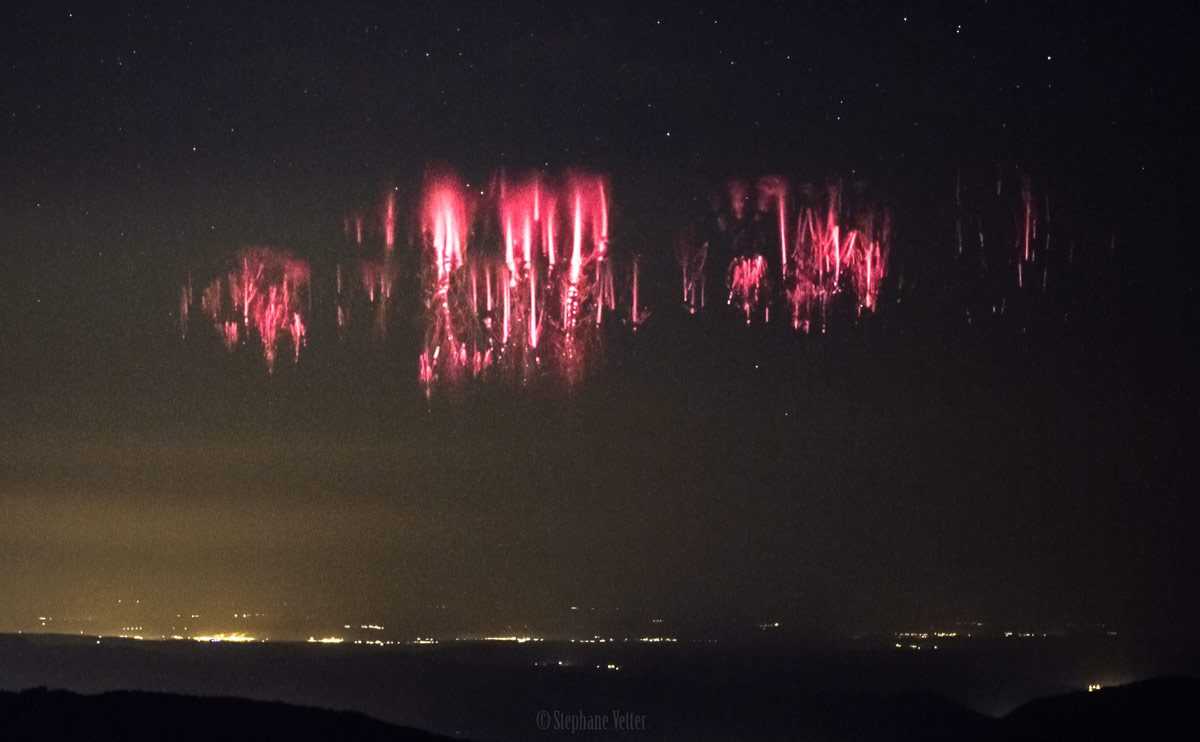
Red Sprites over the Channel
Image Credit & Copyright: Stephane Vetter (Nuits sacrees, TWAN)
Explanation: Mysterious and incredibly brief, red sprites are seen to occur high above large thunderstorms on planet Earth. While they have been recorded from low Earth orbit or high flying airplanes, these dancing, lightning-like events were captured in video frames from a mountain top perch in northern France. Taken during the night of May 28, the remarkably clear, unobstructed view looks toward a multicell storm system raging over the English Channel about 600 kilometers away. Lasting only a few milliseconds, the red sprite association with thunderstorms is known. Still, much remains a mystery about the fleeting apparitions including the nature of their relation to other upper atmospheric lightning phenomena such as blue jets or satellite detected terrestrial gamma flashes.

Red Sprites over the Channel
Image Credit & Copyright: Stephane Vetter (Nuits sacrees, TWAN)
Explanation: Mysterious and incredibly brief, red sprites are seen to occur high above large thunderstorms on planet Earth. While they have been recorded from low Earth orbit or high flying airplanes, these dancing, lightning-like events were captured in video frames from a mountain top perch in northern France. Taken during the night of May 28, the remarkably clear, unobstructed view looks toward a multicell storm system raging over the English Channel about 600 kilometers away. Lasting only a few milliseconds, the red sprite association with thunderstorms is known. Still, much remains a mystery about the fleeting apparitions including the nature of their relation to other upper atmospheric lightning phenomena such as blue jets or satellite detected terrestrial gamma flashes.

panosol- Αριθμός μηνυμάτων : 762
Points : 927
Reputation : 15
Ημερομηνία εγγραφής : 17/06/2012
Ηλικία : 56
 2017 June 16
2017 June 16
2017 June 16
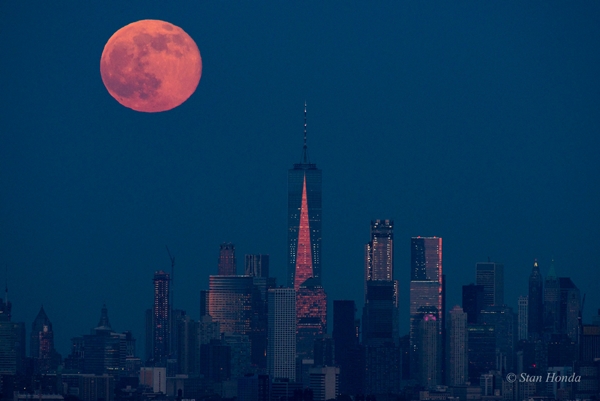
Manhattan Moonrise
Image Credit & Copyright: Stan Honda
Explanation: A Full Moon rose as the Sun set on June 9, known to some as a Strawberry Moon. Close to the horizon and taking on the warm color of reflected sunlight filtered through a dense and dusty atmosphere, the fully illuminated lunar disk poses with the skyscrapers along the southern Manhattan skyline in this telephoto snapshot. The picture was taken from Eagle Rock Reservation, a park in West Orange, New Jersey, planet Earth. That's about 13 miles from southern Manhattan and some 240,000 miles from the Moon. Foreground faces of the modern towers of steel and glass share the Moon's warm color by reflecting the last rays of the setting Sun. The tallest, with the shining triangular facet, is New York City's One World Trade center.

Manhattan Moonrise
Image Credit & Copyright: Stan Honda
Explanation: A Full Moon rose as the Sun set on June 9, known to some as a Strawberry Moon. Close to the horizon and taking on the warm color of reflected sunlight filtered through a dense and dusty atmosphere, the fully illuminated lunar disk poses with the skyscrapers along the southern Manhattan skyline in this telephoto snapshot. The picture was taken from Eagle Rock Reservation, a park in West Orange, New Jersey, planet Earth. That's about 13 miles from southern Manhattan and some 240,000 miles from the Moon. Foreground faces of the modern towers of steel and glass share the Moon's warm color by reflecting the last rays of the setting Sun. The tallest, with the shining triangular facet, is New York City's One World Trade center.

panosol- Αριθμός μηνυμάτων : 762
Points : 927
Reputation : 15
Ημερομηνία εγγραφής : 17/06/2012
Ηλικία : 56
 2017 June 17
2017 June 17
2017 June 17

Saturn near Opposition
Image Credit & Copyright: D. Peach, E. Kraaikamp, F. Colas, M. Delcroix, R. Hueso, G. Therin, C. Sprianu, S2P, IMCCE, OMP
Explanation: Saturn reached its 2017 opposition on June 16. Of course, opposition means opposite the Sun in Earth's sky and near opposition Saturn is up all night, at its closest and brightest for the year. This remarkably sharp image of the ringed planet was taken only days before, on June 11, with a 1-meter telescope from the mountain top Pic du Midi observatory. North is at the top with the giant planet's north polar storm and curious hexagon clearly seen bathed in sunlight. But Saturn's spectacular ring system is also shown in stunning detail. The narrow Encke division is visible around the entire outer A ring, small ringlets can be traced within the fainter inner C ring, and Saturn's southern hemisphere can be glimpsed through the wider Cassini division. Near opposition Saturn's rings also appear exceptionally bright, known as the opposition surge or Seeliger Effect. Directly illuminated from Earth's perspective, the ring's icy particles cast no shadows and strongly backscatter sunlight creating the dramatic increase in brightness. Still, the best views of the ringed planet are currently from the Saturn-orbiting Cassini spacecraft. Diving close, Cassini's Grand Finale orbit number 9 is in progress.

Saturn near Opposition
Image Credit & Copyright: D. Peach, E. Kraaikamp, F. Colas, M. Delcroix, R. Hueso, G. Therin, C. Sprianu, S2P, IMCCE, OMP
Explanation: Saturn reached its 2017 opposition on June 16. Of course, opposition means opposite the Sun in Earth's sky and near opposition Saturn is up all night, at its closest and brightest for the year. This remarkably sharp image of the ringed planet was taken only days before, on June 11, with a 1-meter telescope from the mountain top Pic du Midi observatory. North is at the top with the giant planet's north polar storm and curious hexagon clearly seen bathed in sunlight. But Saturn's spectacular ring system is also shown in stunning detail. The narrow Encke division is visible around the entire outer A ring, small ringlets can be traced within the fainter inner C ring, and Saturn's southern hemisphere can be glimpsed through the wider Cassini division. Near opposition Saturn's rings also appear exceptionally bright, known as the opposition surge or Seeliger Effect. Directly illuminated from Earth's perspective, the ring's icy particles cast no shadows and strongly backscatter sunlight creating the dramatic increase in brightness. Still, the best views of the ringed planet are currently from the Saturn-orbiting Cassini spacecraft. Diving close, Cassini's Grand Finale orbit number 9 is in progress.

panosol- Αριθμός μηνυμάτων : 762
Points : 927
Reputation : 15
Ημερομηνία εγγραφής : 17/06/2012
Ηλικία : 56
 2017 June 18
2017 June 18
2017 June 18
Views from Cassini at Saturn
Credit: Images: Cassini Imaging Team, ISS, JPL, ESA, NASA; Video Compilation: Chris Abbas;
Music Credit & License: Ghosts I-IV (Nine Inch Nails)
Explanation: What has the Cassini orbiter seen at Saturn? The featured music video shows some of the early highlights. In the first time-lapse sequence (00:07), a vertical line appears that is really Saturn's thin rings seen nearly edge-on. Soon some of Saturn's moon shoot past. The next sequence (00:11) features Saturn's unusually wavy F-ring that is constrained by the two shepherd moons that are also continually perturbing it. Soon much of Saturn's extensive ring system flashes by, sometimes juxtaposed to the grandeur of the immense planet itself. Cloud patterns on Titan (00:39) and Saturn (00:41) are highlighted. Clips from flybys of several of Saturn's moon are then shown, including Phoebe, Mimas, Epimetheus, and Iapetus. In other sequences, moons of Saturn appear to pass each other as they orbit Saturn. Background star fields seen by Cassini are sometimes intruded upon by bright passing moons. The robotic Cassini spacecraft has been revolutionizing humanity's knowledge of Saturn and its moons since 2004. In September, Cassini's mission will be brought to a dramatic conclusion as the spacecraft will be directed to dive into ringed giant.
Views from Cassini at Saturn
Credit: Images: Cassini Imaging Team, ISS, JPL, ESA, NASA; Video Compilation: Chris Abbas;
Music Credit & License: Ghosts I-IV (Nine Inch Nails)
Explanation: What has the Cassini orbiter seen at Saturn? The featured music video shows some of the early highlights. In the first time-lapse sequence (00:07), a vertical line appears that is really Saturn's thin rings seen nearly edge-on. Soon some of Saturn's moon shoot past. The next sequence (00:11) features Saturn's unusually wavy F-ring that is constrained by the two shepherd moons that are also continually perturbing it. Soon much of Saturn's extensive ring system flashes by, sometimes juxtaposed to the grandeur of the immense planet itself. Cloud patterns on Titan (00:39) and Saturn (00:41) are highlighted. Clips from flybys of several of Saturn's moon are then shown, including Phoebe, Mimas, Epimetheus, and Iapetus. In other sequences, moons of Saturn appear to pass each other as they orbit Saturn. Background star fields seen by Cassini are sometimes intruded upon by bright passing moons. The robotic Cassini spacecraft has been revolutionizing humanity's knowledge of Saturn and its moons since 2004. In September, Cassini's mission will be brought to a dramatic conclusion as the spacecraft will be directed to dive into ringed giant.

panosol- Αριθμός μηνυμάτων : 762
Points : 927
Reputation : 15
Ημερομηνία εγγραφής : 17/06/2012
Ηλικία : 56
 Απ: Astronomy Picture of the Day
Απ: Astronomy Picture of the Day
2017 June 19
Eclipse Across America: Path Prediction Video
Video Credit: NASA GSFC's Scientific Visualization Studio; Blue Marble data courtesy Reto Stöckli (NASA/GSFC)
Explanation: Where will you be during the Eclipse across America? On August 21, the shadow of the Moon will cross the continental USA for the first time since 1979. The predicted path -- a certainty given modern astronomical knowledge -- is shown in the featured NASA video. Most people in the USA will be within a day's drive to the path of the total solar eclipse, while the rest of North America will see a partial solar eclipse. In the path of totality, given clear-enough skies, the Moon will block out the Sun making it eerily dark for as long as 2 minutes and 40 seconds. If interested in attending an eclipse party, please contact your local amateur astronomical society, science center, park, or university to see if one is already being planning. Some eclipse chasers have traveled to the end of the world to see a total eclipse of the Sun, and along the way have recorded many entertaining adventure stories.
Eclipse Across America: Path Prediction Video
Video Credit: NASA GSFC's Scientific Visualization Studio; Blue Marble data courtesy Reto Stöckli (NASA/GSFC)
Explanation: Where will you be during the Eclipse across America? On August 21, the shadow of the Moon will cross the continental USA for the first time since 1979. The predicted path -- a certainty given modern astronomical knowledge -- is shown in the featured NASA video. Most people in the USA will be within a day's drive to the path of the total solar eclipse, while the rest of North America will see a partial solar eclipse. In the path of totality, given clear-enough skies, the Moon will block out the Sun making it eerily dark for as long as 2 minutes and 40 seconds. If interested in attending an eclipse party, please contact your local amateur astronomical society, science center, park, or university to see if one is already being planning. Some eclipse chasers have traveled to the end of the world to see a total eclipse of the Sun, and along the way have recorded many entertaining adventure stories.

panosol- Αριθμός μηνυμάτων : 762
Points : 927
Reputation : 15
Ημερομηνία εγγραφής : 17/06/2012
Ηλικία : 56
 2017 June 20
2017 June 20
2017 June 20
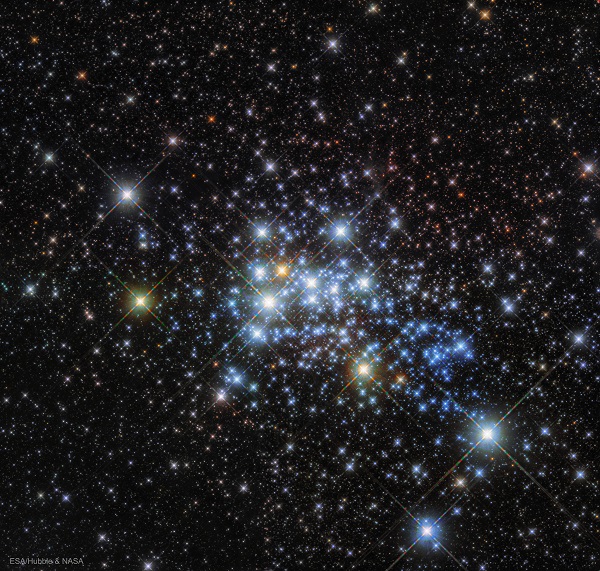
The Massive Stars in Westerlund 1
Image Credit: ESA/Hubble & NASA
Explanation: Star cluster Westerlund 1 is home to some of the largest and most massive stars known. It is headlined by the star Westerlund 1-26, a red supergiant star so big that if placed in the center of our Solar System, it would extend out past the orbit of Jupiter. Additionally, the young star cluster is home to 3 other red supergiants, 6 yellow hypergiant stars, 24 Wolf-Rayet stars, and several even-more unusual stars that continue to be studied. Westerlund 1 is relatively close-by for a star cluster at a distance of 15,000 light years, giving astronomers a good laboratory to study the development of massive stars. The featured image of Westerlund 1 was taken by the Hubble Space Telescope toward the southern constellation of the Altar (Ara). Although presently classified as a "super" open cluster, Westerlund 1 may evolve into a low mass globular cluster over the next billion years.

The Massive Stars in Westerlund 1
Image Credit: ESA/Hubble & NASA
Explanation: Star cluster Westerlund 1 is home to some of the largest and most massive stars known. It is headlined by the star Westerlund 1-26, a red supergiant star so big that if placed in the center of our Solar System, it would extend out past the orbit of Jupiter. Additionally, the young star cluster is home to 3 other red supergiants, 6 yellow hypergiant stars, 24 Wolf-Rayet stars, and several even-more unusual stars that continue to be studied. Westerlund 1 is relatively close-by for a star cluster at a distance of 15,000 light years, giving astronomers a good laboratory to study the development of massive stars. The featured image of Westerlund 1 was taken by the Hubble Space Telescope toward the southern constellation of the Altar (Ara). Although presently classified as a "super" open cluster, Westerlund 1 may evolve into a low mass globular cluster over the next billion years.

panosol- Αριθμός μηνυμάτων : 762
Points : 927
Reputation : 15
Ημερομηνία εγγραφής : 17/06/2012
Ηλικία : 56
 2017 June 21
2017 June 21
2017 June 21

A Sundial that Shows Solstice
Image Credit & Copyright: Jean-Marc Mari
Explanation: What day is it? If the day -- and time -- are right, this sundial will tell you: SOLSTICE. Only then will our Sun be located just right for sunlight to stream through openings and spell out the term for the longest and shortest days of the year. But this will happen today (and again in December). The sundial was constructed by Jean Salins in 1980 and is situated at the Ecole Supérieure des Mines de Paris in Valbonne Sophia Antipolis of south-eastern France. On two other days of the year, watchers of this sundial might get to see it produce another word: EQUINOXE.

A Sundial that Shows Solstice
Image Credit & Copyright: Jean-Marc Mari
Explanation: What day is it? If the day -- and time -- are right, this sundial will tell you: SOLSTICE. Only then will our Sun be located just right for sunlight to stream through openings and spell out the term for the longest and shortest days of the year. But this will happen today (and again in December). The sundial was constructed by Jean Salins in 1980 and is situated at the Ecole Supérieure des Mines de Paris in Valbonne Sophia Antipolis of south-eastern France. On two other days of the year, watchers of this sundial might get to see it produce another word: EQUINOXE.

panosol- Αριθμός μηνυμάτων : 762
Points : 927
Reputation : 15
Ημερομηνία εγγραφής : 17/06/2012
Ηλικία : 56
 2017 June 22
2017 June 22
2017 June 22
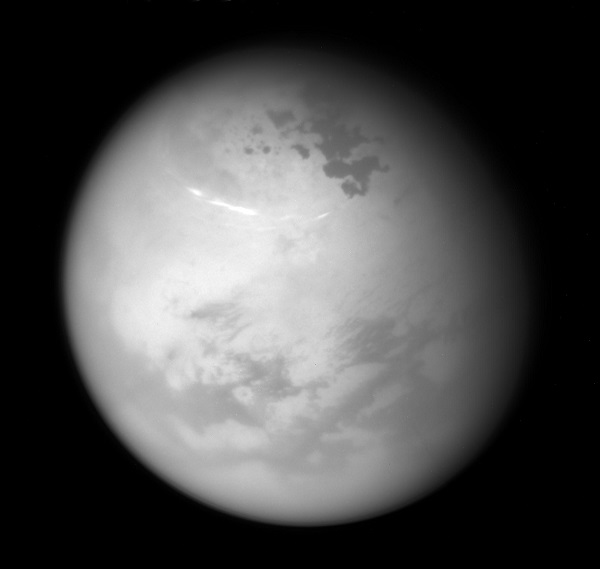
Northern Summer on Titan
Image Credit: Cassini Imaging Team, SSI, JPL, ESA, NASA
Explanation: While yesterday's solstice brought summer to planet Earth's northern hemisphere, a northern summer solstice arrived for ringed planet Saturn nearly a month ago on May 24. Following the Saturnian seasons, its large moon Titan was captured in this Cassini spacecraft image from June 9. The near-infrared view finds bright methane clouds drifting through Titan's northern summer skies as seen from a distance of about 507,000 kilometers. Below Titan's clouds, dark hydrocarbon lakes sprawl near the large moon's now illuminated north pole.

Northern Summer on Titan
Image Credit: Cassini Imaging Team, SSI, JPL, ESA, NASA
Explanation: While yesterday's solstice brought summer to planet Earth's northern hemisphere, a northern summer solstice arrived for ringed planet Saturn nearly a month ago on May 24. Following the Saturnian seasons, its large moon Titan was captured in this Cassini spacecraft image from June 9. The near-infrared view finds bright methane clouds drifting through Titan's northern summer skies as seen from a distance of about 507,000 kilometers. Below Titan's clouds, dark hydrocarbon lakes sprawl near the large moon's now illuminated north pole.

panosol- Αριθμός μηνυμάτων : 762
Points : 927
Reputation : 15
Ημερομηνία εγγραφής : 17/06/2012
Ηλικία : 56
 2017 June 23
2017 June 23
2017 June 23

Solstice Conjunction over Budapest
Image Credit & Copyright: György Soponyai
Explanation: Before a solstice Sun rose on June 21, brilliant Venus and an old crescent Moon posed together over Budapest, Hungary for this predawn skyscape. In the foreground the view looks across the Danube river from Buda to Pest toward the dome and peaks of the Hungarian Parliament building. Low clouds are in silhouette against a twilight sky. But far enough above the eastern horizon to catch the sunlight shines another seasonal apparition on that solstice morning, noctilucent clouds. Seen near sunrise and sunset in summer months at high latitudes, the night-shining clouds are formed as water vapor in the cold upper atmosphere condenses on meteoric dust or volcanic ash near the edge of space.

Solstice Conjunction over Budapest
Image Credit & Copyright: György Soponyai
Explanation: Before a solstice Sun rose on June 21, brilliant Venus and an old crescent Moon posed together over Budapest, Hungary for this predawn skyscape. In the foreground the view looks across the Danube river from Buda to Pest toward the dome and peaks of the Hungarian Parliament building. Low clouds are in silhouette against a twilight sky. But far enough above the eastern horizon to catch the sunlight shines another seasonal apparition on that solstice morning, noctilucent clouds. Seen near sunrise and sunset in summer months at high latitudes, the night-shining clouds are formed as water vapor in the cold upper atmosphere condenses on meteoric dust or volcanic ash near the edge of space.

panosol- Αριθμός μηνυμάτων : 762
Points : 927
Reputation : 15
Ημερομηνία εγγραφής : 17/06/2012
Ηλικία : 56
 2017 June 24
2017 June 24
2017 June 24
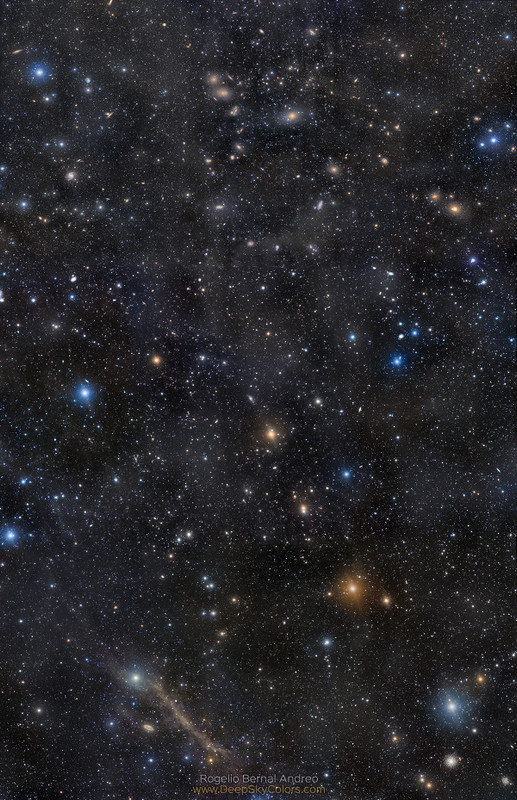
Markarian's Chain to Messier 64
Image Credit & Copyright: Rogelio Bernal Andreo (Deep Sky Colors)
Explanation: Top to bottom, this colorful and broad telescopic mosaic links Markarian's Chain of galaxies across the core of the Virgo Cluster to dusty spiral galaxy Messier 64. Galaxies are scattered through the field of view that spans some 20 full moons across a gorgeous night sky. The cosmic frame is also filled with foreground stars from constellations Virgo and the well-groomed Coma Berenices, and faint, dusty nebulae drifting above the plane of the Milky Way. Look carefully for Markarian's eyes. The famous pair of interacting galaxies is near the top, not far from M87, the Virgo cluster's giant elliptical galaxy. At the bottom, you can stare down Messier 64, also known as the Black Eye Galaxy. The Virgo Cluster is the closest large galaxy cluster to our own local galaxy group. Virgo Cluster galaxies are about 50 million light-years distant, but M64 lies a mere 17 million light-years away.

Markarian's Chain to Messier 64
Image Credit & Copyright: Rogelio Bernal Andreo (Deep Sky Colors)
Explanation: Top to bottom, this colorful and broad telescopic mosaic links Markarian's Chain of galaxies across the core of the Virgo Cluster to dusty spiral galaxy Messier 64. Galaxies are scattered through the field of view that spans some 20 full moons across a gorgeous night sky. The cosmic frame is also filled with foreground stars from constellations Virgo and the well-groomed Coma Berenices, and faint, dusty nebulae drifting above the plane of the Milky Way. Look carefully for Markarian's eyes. The famous pair of interacting galaxies is near the top, not far from M87, the Virgo cluster's giant elliptical galaxy. At the bottom, you can stare down Messier 64, also known as the Black Eye Galaxy. The Virgo Cluster is the closest large galaxy cluster to our own local galaxy group. Virgo Cluster galaxies are about 50 million light-years distant, but M64 lies a mere 17 million light-years away.

panosol- Αριθμός μηνυμάτων : 762
Points : 927
Reputation : 15
Ημερομηνία εγγραφής : 17/06/2012
Ηλικία : 56
 2017 June 25
2017 June 25
2017 June 25

The N44 Superbubble
Image Credit & Copyright: Gemini Obs., AURA, NSF
Explanation: What created this gigantic hole? The vast emission nebula N44 in our neighboring galaxy the Large Magellanic Cloud has a large, 250 light-year hole and astronomers are trying to figure out why. One possibility is particle winds expelled by massive stars in the bubble's interior that are pushing out the glowing gas. This answer was found to be inconsistent with measured wind velocities, however. Another possibility is that the expanding shells of old supernovas have sculpted the unusual space cavern. An unexpected clue of hot X-ray emitting gas was recently been detected escaping the N44 superbubble. The featured image was taken in three very specific colors by the huge 8-meter Gemini South Telescope on Cerro Pachon in Chile.

The N44 Superbubble
Image Credit & Copyright: Gemini Obs., AURA, NSF
Explanation: What created this gigantic hole? The vast emission nebula N44 in our neighboring galaxy the Large Magellanic Cloud has a large, 250 light-year hole and astronomers are trying to figure out why. One possibility is particle winds expelled by massive stars in the bubble's interior that are pushing out the glowing gas. This answer was found to be inconsistent with measured wind velocities, however. Another possibility is that the expanding shells of old supernovas have sculpted the unusual space cavern. An unexpected clue of hot X-ray emitting gas was recently been detected escaping the N44 superbubble. The featured image was taken in three very specific colors by the huge 8-meter Gemini South Telescope on Cerro Pachon in Chile.

panosol- Αριθμός μηνυμάτων : 762
Points : 927
Reputation : 15
Ημερομηνία εγγραφής : 17/06/2012
Ηλικία : 56
 2017 June 26
2017 June 26
2017 June 26

Artistic Impression: The Surface of TRAPPIST-1f
Illustration Credit: NASA, JPL-Caltech, Spitzer Team, T. Pyle (IPAC)
Explanation: If you could stand on the surface of the newly discovered Earth-sized exoplanet TRAPPIST-1f, what would you see? Presently, no Earthling knows for sure, but the featured illustration depicts a reasoned guess based on observational data taken by NASA's Sun-orbiting Spitzer Space Telescope. In 2017, four more Earth-sized planets were found by Spitzer, including TRAPPIST-1f, in addition to three discovered in 2015 from the ground. From the planet's surface, near the mild terminator between night and day, you might see water, ice, and rock on the ground, while water-based clouds might hover above. Past the clouds, the small central star TRAPPIST-1 would appear more red than our Sun, but angularly larger due to the close orbit. With seven known Earth-sized planets -- many of which pass near each other -- the TRAPPIST-1 system is not only a candidate to have life, but intercommunicating life -- although a preliminary search has found no obvious transmissions.

Artistic Impression: The Surface of TRAPPIST-1f
Illustration Credit: NASA, JPL-Caltech, Spitzer Team, T. Pyle (IPAC)
Explanation: If you could stand on the surface of the newly discovered Earth-sized exoplanet TRAPPIST-1f, what would you see? Presently, no Earthling knows for sure, but the featured illustration depicts a reasoned guess based on observational data taken by NASA's Sun-orbiting Spitzer Space Telescope. In 2017, four more Earth-sized planets were found by Spitzer, including TRAPPIST-1f, in addition to three discovered in 2015 from the ground. From the planet's surface, near the mild terminator between night and day, you might see water, ice, and rock on the ground, while water-based clouds might hover above. Past the clouds, the small central star TRAPPIST-1 would appear more red than our Sun, but angularly larger due to the close orbit. With seven known Earth-sized planets -- many of which pass near each other -- the TRAPPIST-1 system is not only a candidate to have life, but intercommunicating life -- although a preliminary search has found no obvious transmissions.

panosol- Αριθμός μηνυμάτων : 762
Points : 927
Reputation : 15
Ημερομηνία εγγραφής : 17/06/2012
Ηλικία : 56
 2017 June 27
2017 June 27
2017 June 27
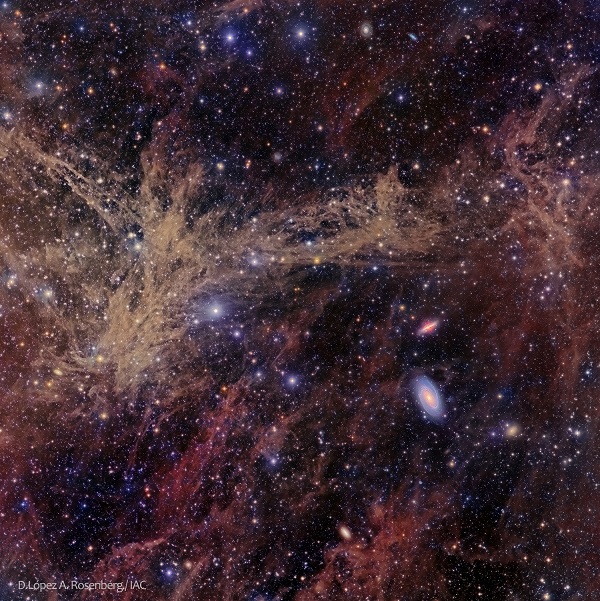
The M81 Galaxy Group through the Integrated Flux Nebula
Image Credit & Copyright : D. Lopez & A. Rosenberg, IAC
Explanation: Distant galaxies and nearby nebulas highlight this deep image of the M81 Group of galaxies. First and foremost in this 80-exposure mosaic is the grand design spiral galaxy M81, the largest galaxy in the image, visible on the lower right. M81 is gravitationally interacting with M82 just above it, a large galaxy with an unusual halo of filamentary red-glowing gas. Around the image many other galaxies from the M81 Group of galaxies can be seen, as well as many foreground Milky Way stars. This whole galaxy menagerie is seen through the glow of an Integrated Flux Nebula (IFN), a vast and complex screen of diffuse gas and dust also in our Milky Way Galaxy. Details of the red and yellow IFN, digitally enhanced, were imaged by a new wide-field camera recently installed at the Teide Observatory in the Canary Islands of Spain.

The M81 Galaxy Group through the Integrated Flux Nebula
Image Credit & Copyright : D. Lopez & A. Rosenberg, IAC
Explanation: Distant galaxies and nearby nebulas highlight this deep image of the M81 Group of galaxies. First and foremost in this 80-exposure mosaic is the grand design spiral galaxy M81, the largest galaxy in the image, visible on the lower right. M81 is gravitationally interacting with M82 just above it, a large galaxy with an unusual halo of filamentary red-glowing gas. Around the image many other galaxies from the M81 Group of galaxies can be seen, as well as many foreground Milky Way stars. This whole galaxy menagerie is seen through the glow of an Integrated Flux Nebula (IFN), a vast and complex screen of diffuse gas and dust also in our Milky Way Galaxy. Details of the red and yellow IFN, digitally enhanced, were imaged by a new wide-field camera recently installed at the Teide Observatory in the Canary Islands of Spain.

panosol- Αριθμός μηνυμάτων : 762
Points : 927
Reputation : 15
Ημερομηνία εγγραφής : 17/06/2012
Ηλικία : 56
 2017 June 28
2017 June 28
2017 June 28
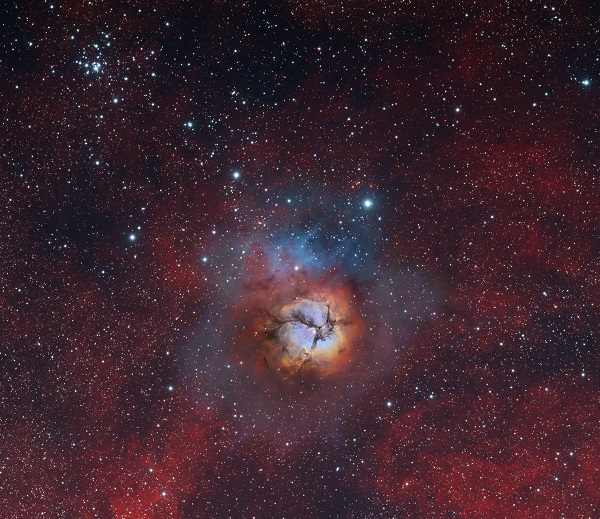
Composite Messier 20 and 21
Image Credit & Copyright: Martin Pugh
Explanation: The beautiful Trifid Nebula, also known as Messier 20, lies about 5,000 light-years away, a colorful study in cosmic contrasts. It shares this nearly 1 degree wide field with open star cluster Messier 21 (top left). Trisected by dust lanes the Trifid itself is about 40 light-years across and a mere 300,000 years old. That makes it one of the youngest star forming regions in our sky, with newborn and embryonic stars embedded in its natal dust and gas clouds. Estimates of the distance to open star cluster M21 are similar to M20's, but though they share this gorgeous telescopic skyscape there is no apparent connection between the two. M21's stars are much older, about 8 million years old. M20 and M21 are easy to find with even a small telescope in the nebula rich constellation Sagittarius. In fact, this well-composed scene is a composite from two different telescopes. Using narrowband data it blends a high resolution image of M20 with a wider field image extending to M21.

Composite Messier 20 and 21
Image Credit & Copyright: Martin Pugh
Explanation: The beautiful Trifid Nebula, also known as Messier 20, lies about 5,000 light-years away, a colorful study in cosmic contrasts. It shares this nearly 1 degree wide field with open star cluster Messier 21 (top left). Trisected by dust lanes the Trifid itself is about 40 light-years across and a mere 300,000 years old. That makes it one of the youngest star forming regions in our sky, with newborn and embryonic stars embedded in its natal dust and gas clouds. Estimates of the distance to open star cluster M21 are similar to M20's, but though they share this gorgeous telescopic skyscape there is no apparent connection between the two. M21's stars are much older, about 8 million years old. M20 and M21 are easy to find with even a small telescope in the nebula rich constellation Sagittarius. In fact, this well-composed scene is a composite from two different telescopes. Using narrowband data it blends a high resolution image of M20 with a wider field image extending to M21.

panosol- Αριθμός μηνυμάτων : 762
Points : 927
Reputation : 15
Ημερομηνία εγγραφής : 17/06/2012
Ηλικία : 56
 2017 June 29
2017 June 29
2017 June 29

Symbiotic R Aquarii
Image Credit: X-ray - NASA,CXC,SAO, R. Montez et al.; Optical - Adam Block, Mt. Lemmon SkyCenter, U. Arizona
Explanation: A long recognized naked-eye variable star, R Aquarii is actually an interacting binary star system, two stars that seem to have a close, symbiotic relationship. About 710 light years away, it consists of a cool red giant star and hot, dense white dwarf star in mutual orbit around their common center of mass. The binary system's visible light is dominated by the red giant, itself a Mira-type long period variable star. But material in cool giant star's extended envelope is pulled by gravity onto the surface of the smaller, denser white dwarf, eventually triggering a thermonuclear explosion and blasting material into space. Optical image data (red) shows the still expanding ring of debris originating from a blast that would have been seen in the early 1770s. The evolution of less understood energetic events producing high energy emission in the R Aquarii system has been monitored since 2000 using Chandra X-ray Observatory data (blue). The composite field of view is less that a light-year across at the estimated distance of R Aquarii.

Symbiotic R Aquarii
Image Credit: X-ray - NASA,CXC,SAO, R. Montez et al.; Optical - Adam Block, Mt. Lemmon SkyCenter, U. Arizona
Explanation: A long recognized naked-eye variable star, R Aquarii is actually an interacting binary star system, two stars that seem to have a close, symbiotic relationship. About 710 light years away, it consists of a cool red giant star and hot, dense white dwarf star in mutual orbit around their common center of mass. The binary system's visible light is dominated by the red giant, itself a Mira-type long period variable star. But material in cool giant star's extended envelope is pulled by gravity onto the surface of the smaller, denser white dwarf, eventually triggering a thermonuclear explosion and blasting material into space. Optical image data (red) shows the still expanding ring of debris originating from a blast that would have been seen in the early 1770s. The evolution of less understood energetic events producing high energy emission in the R Aquarii system has been monitored since 2000 using Chandra X-ray Observatory data (blue). The composite field of view is less that a light-year across at the estimated distance of R Aquarii.

panosol- Αριθμός μηνυμάτων : 762
Points : 927
Reputation : 15
Ημερομηνία εγγραφής : 17/06/2012
Ηλικία : 56
 2017 June 30
2017 June 30
2017 June 30

NGC 7814: The Little Sombrero in Pegasus
Image Credit & Copyright: CHART32 Team, Processing - Johannes Schedler
Explanation: Point your telescope toward the high flying constellation Pegasus and you can find this expanse of Milky Way stars and distant galaxies. Dominated by NGC 7814, the pretty field of view would almost be covered by a full moon. NGC 7814 is sometimes called the Little Sombrero for its resemblance to the brighter more famous M104, the Sombrero Galaxy. Both Sombrero and Little Sombrero are spiral galaxies seen edge-on, and both have extensive halos and central bulges cut by a thin disk with thinner dust lanes in silhouette. In fact, NGC 7814 is some 40 million light-years away and an estimated 60,000 light-years across. That actually makes the Little Sombrero about the same physical size as its better known namesake, appearing smaller and fainter only because it is farther away. Very faint dwarf galaxies, potentially a satellites of NGC 7814, have been discovered in deep exposures of Little Sombrero.

NGC 7814: The Little Sombrero in Pegasus
Image Credit & Copyright: CHART32 Team, Processing - Johannes Schedler
Explanation: Point your telescope toward the high flying constellation Pegasus and you can find this expanse of Milky Way stars and distant galaxies. Dominated by NGC 7814, the pretty field of view would almost be covered by a full moon. NGC 7814 is sometimes called the Little Sombrero for its resemblance to the brighter more famous M104, the Sombrero Galaxy. Both Sombrero and Little Sombrero are spiral galaxies seen edge-on, and both have extensive halos and central bulges cut by a thin disk with thinner dust lanes in silhouette. In fact, NGC 7814 is some 40 million light-years away and an estimated 60,000 light-years across. That actually makes the Little Sombrero about the same physical size as its better known namesake, appearing smaller and fainter only because it is farther away. Very faint dwarf galaxies, potentially a satellites of NGC 7814, have been discovered in deep exposures of Little Sombrero.

panosol- Αριθμός μηνυμάτων : 762
Points : 927
Reputation : 15
Ημερομηνία εγγραφής : 17/06/2012
Ηλικία : 56
 2017 July 1
2017 July 1
2017 July 1

3D Lava Falls of Mars
Image Credit: NASA, MRO, HiRISE, JPL, U. Arizona
Explanation: Get out your red/cyan glasses and gaze across lava falls of Mars. The stereo anaglyph was created by combining two images recorded by the HiRISE camera onboard Mars Reconnaissance Orbiter. The multi-level falls were created as flowing lava breached sections of the northern rim of a 30-kilometer diameter martian crater, located in the western part of the Red Planet's volcanic Tharsis region. As the molten lava cascaded down the crater wall and terraces to reach the crater floor it left the distinctly rough, fan-shaped flows on the steeper slopes. North is up and the breathtaking 3D view is 5 kilometers wide.

3D Lava Falls of Mars
Image Credit: NASA, MRO, HiRISE, JPL, U. Arizona
Explanation: Get out your red/cyan glasses and gaze across lava falls of Mars. The stereo anaglyph was created by combining two images recorded by the HiRISE camera onboard Mars Reconnaissance Orbiter. The multi-level falls were created as flowing lava breached sections of the northern rim of a 30-kilometer diameter martian crater, located in the western part of the Red Planet's volcanic Tharsis region. As the molten lava cascaded down the crater wall and terraces to reach the crater floor it left the distinctly rough, fan-shaped flows on the steeper slopes. North is up and the breathtaking 3D view is 5 kilometers wide.

panosol- Αριθμός μηνυμάτων : 762
Points : 927
Reputation : 15
Ημερομηνία εγγραφής : 17/06/2012
Ηλικία : 56
 2017 July 2
2017 July 2
2017 July 2
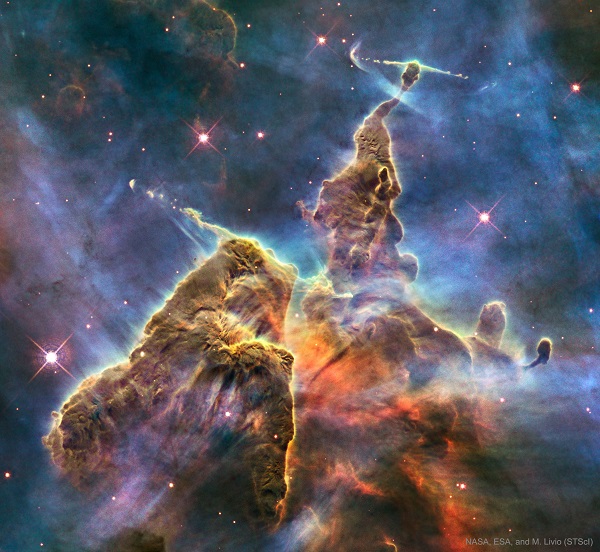
Mountains of Dust in the Carina Nebula
Image Credit: NASA, ESA, and M. Livio (STScI)
Explanation: It's stars versus dust in the Carina Nebula and the stars are winning. More precisely, the energetic light and winds from massive newly formed stars are evaporating and dispersing the dusty stellar nurseries in which they formed. Located in the Carina Nebula and known informally as Mystic Mountain, these pillar's appearance is dominated by the dark dust even though it is composed mostly of clear hydrogen gas. Dust pillars such as these are actually much thinner than air and only appear as mountains due to relatively small amounts of opaque interstellar dust. About 7,500 light-years distant, the featured image was taken with the Hubble Space Telescope and highlights an interior region of Carina which spans about three light years. Within a few million years, the stars will likely win out completely and the entire dust mountain will evaporate.

Mountains of Dust in the Carina Nebula
Image Credit: NASA, ESA, and M. Livio (STScI)
Explanation: It's stars versus dust in the Carina Nebula and the stars are winning. More precisely, the energetic light and winds from massive newly formed stars are evaporating and dispersing the dusty stellar nurseries in which they formed. Located in the Carina Nebula and known informally as Mystic Mountain, these pillar's appearance is dominated by the dark dust even though it is composed mostly of clear hydrogen gas. Dust pillars such as these are actually much thinner than air and only appear as mountains due to relatively small amounts of opaque interstellar dust. About 7,500 light-years distant, the featured image was taken with the Hubble Space Telescope and highlights an interior region of Carina which spans about three light years. Within a few million years, the stars will likely win out completely and the entire dust mountain will evaporate.

panosol- Αριθμός μηνυμάτων : 762
Points : 927
Reputation : 15
Ημερομηνία εγγραφής : 17/06/2012
Ηλικία : 56
 2017 July 3
2017 July 3
2017 July 3
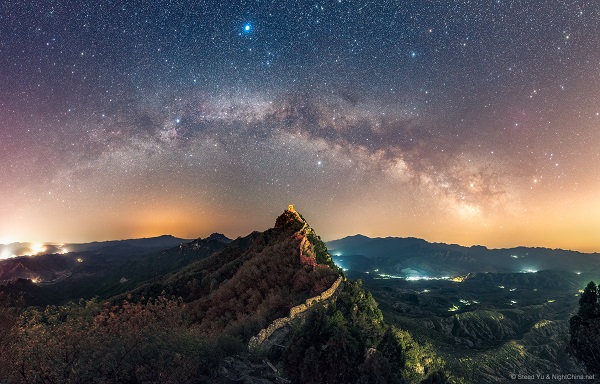
The Summer Triangle over the Great Wall
Image Credit & Copyright: Steed Yu & NightChina.net
Explanation: Have you ever seen the Summer Triangle? The bright stars Vega, Deneb, and Altair form a large triangle on the sky that can be seen rising in the northern spring during the morning, and rising in the northern fall during the evening. During summer months, the triangle can be found nearly overhead near midnight as three of the brightest stars on the sky. Featured here, along with the arch of the central band of our Milky Way Galaxy, the Summer Triangle asterism was captured this spring over the Great Wall of China. This part of the Great Wall, a World Culture Heritage Site, was built during the 6th century on the Yan Mountains. At the summit is Wangjinglou Tower from which, on a clear night, the lights of Beijing are visible in the distance.

The Summer Triangle over the Great Wall
Image Credit & Copyright: Steed Yu & NightChina.net
Explanation: Have you ever seen the Summer Triangle? The bright stars Vega, Deneb, and Altair form a large triangle on the sky that can be seen rising in the northern spring during the morning, and rising in the northern fall during the evening. During summer months, the triangle can be found nearly overhead near midnight as three of the brightest stars on the sky. Featured here, along with the arch of the central band of our Milky Way Galaxy, the Summer Triangle asterism was captured this spring over the Great Wall of China. This part of the Great Wall, a World Culture Heritage Site, was built during the 6th century on the Yan Mountains. At the summit is Wangjinglou Tower from which, on a clear night, the lights of Beijing are visible in the distance.

panosol- Αριθμός μηνυμάτων : 762
Points : 927
Reputation : 15
Ημερομηνία εγγραφής : 17/06/2012
Ηλικία : 56
 2017 July 4
2017 July 4
2017 July 4
Celestial Fireworks: Into Star Cluster Westerlund 2
Visualization Credit: NASA, ESA, Hubble, J. Anderson et al. (STScI); Acknowledgment: The Hubble Heritage Team (STScI/AURA), A. Nota (ESA/STScI), the Westerlund 2 Science Team, and the ESO
Explanation: What if you could go right into a cluster where stars are forming? A one-minute, time-lapse, video visualization of just this has been made with 3D computer modeling of the region surrounding the star cluster Westerlund 2, based on images from the Hubble Space Telescope in visible and infrared light. Westerlund 2 spans about 10 light years across and lies about 20,000 light years distant toward the constellation of the Ship's Keel (Carina). As the illustrative animation begins, the greater Gum 29 nebula fills the screen, with the young cluster of bright stars visible in the center. Stars zip past you as you approach the cluster. Soon your imaginary ship pivots and you pass over light-year long pillars of interstellar gas and dust. Strong winds and radiation from massive young stars destroy all but the densest nearby dust clumps, leaving these pillars in their shadows -- many pointing back toward the cluster center. Last, you pass into the top of the star cluster and survey hundreds of the most massive stars known.
Celestial Fireworks: Into Star Cluster Westerlund 2
Visualization Credit: NASA, ESA, Hubble, J. Anderson et al. (STScI); Acknowledgment: The Hubble Heritage Team (STScI/AURA), A. Nota (ESA/STScI), the Westerlund 2 Science Team, and the ESO
Explanation: What if you could go right into a cluster where stars are forming? A one-minute, time-lapse, video visualization of just this has been made with 3D computer modeling of the region surrounding the star cluster Westerlund 2, based on images from the Hubble Space Telescope in visible and infrared light. Westerlund 2 spans about 10 light years across and lies about 20,000 light years distant toward the constellation of the Ship's Keel (Carina). As the illustrative animation begins, the greater Gum 29 nebula fills the screen, with the young cluster of bright stars visible in the center. Stars zip past you as you approach the cluster. Soon your imaginary ship pivots and you pass over light-year long pillars of interstellar gas and dust. Strong winds and radiation from massive young stars destroy all but the densest nearby dust clumps, leaving these pillars in their shadows -- many pointing back toward the cluster center. Last, you pass into the top of the star cluster and survey hundreds of the most massive stars known.

panosol- Αριθμός μηνυμάτων : 762
Points : 927
Reputation : 15
Ημερομηνία εγγραφής : 17/06/2012
Ηλικία : 56
 2017 July 5
2017 July 5
2017 July 5
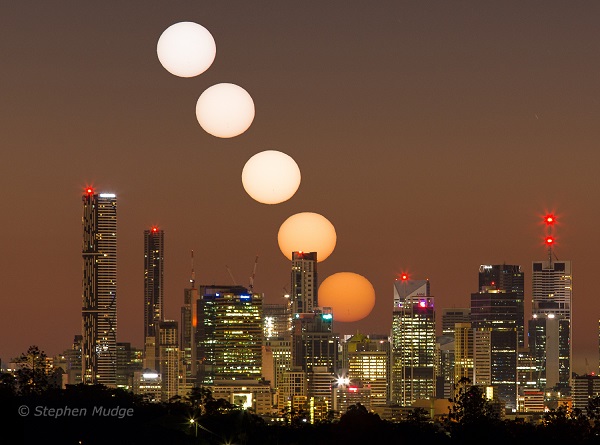
Aphelion Sunrise
Image Credit & Copyright: Stephen Mudge
Explanation: On July 3rd, planet Earth reached aphelion, the farthest point in its elliptical orbit around the Sun. Each year, this day of the most distant Sun happens to occur during winter in the southern hemisphere. That's where this aphelion sunrise from 2015 was captured in a time series composite against the skyline of Brisbane, Australia. Of course, seasons for our fair planet are not determined by distance to the Sun, but by the tilt of Earth's rotational axis with respect to the ecliptic, the plane of its orbit. Fondly known as the obliquity of the ecliptic, the angle of the tilt is about 23.4 degrees from perpendicular to the orbital plane. So the most distant sunrise occurs during northern summer, when the planet's north pole is tilted toward the Sun and the north enjoys longer, warmer days.

Aphelion Sunrise
Image Credit & Copyright: Stephen Mudge
Explanation: On July 3rd, planet Earth reached aphelion, the farthest point in its elliptical orbit around the Sun. Each year, this day of the most distant Sun happens to occur during winter in the southern hemisphere. That's where this aphelion sunrise from 2015 was captured in a time series composite against the skyline of Brisbane, Australia. Of course, seasons for our fair planet are not determined by distance to the Sun, but by the tilt of Earth's rotational axis with respect to the ecliptic, the plane of its orbit. Fondly known as the obliquity of the ecliptic, the angle of the tilt is about 23.4 degrees from perpendicular to the orbital plane. So the most distant sunrise occurs during northern summer, when the planet's north pole is tilted toward the Sun and the north enjoys longer, warmer days.

panosol- Αριθμός μηνυμάτων : 762
Points : 927
Reputation : 15
Ημερομηνία εγγραφής : 17/06/2012
Ηλικία : 56
Σελίδα 8 από 15 •  1 ... 5 ... 7, 8, 9 ... 11 ... 15
1 ... 5 ... 7, 8, 9 ... 11 ... 15 
Σελίδα 8 από 15
Δικαιώματα σας στην κατηγορία αυτή
Δεν μπορείτε να απαντήσετε στα Θέματα αυτής της Δ.Συζήτησης|
|
|

 Αρχική
Αρχική Φόρουμ
Φόρουμ RADIO
RADIO ΠΑΙΓΝΙΔΙΑ
ΠΑΙΓΝΙΔΙΑ Latest images
Latest images Εγγραφή
Εγγραφή Σύνδεση
Σύνδεση




» ΚΑΛΗ ΑΝΑΣΤΑΣΗ ΚΑΙ ΚΑΛΟ ΠΑΣΧΑ!!
» Εφυγε από τη ζωή ο Τζίμης Πανούσης
» ΧΡΟΝΙΑ ΠΟΛΛΑ ΚΑΙ ΚΑΛΗ ΧΡΟΝΙΑ ΜΕ ΥΓΕΙΑ ΚΑΙ ΕΥΤΥΧΙΑ!!!
» This day in music
» Astronomy Picture of the Day
» Τις καλύτερες ευχές μου για Ευτυχισμένα Χριστούγεννα σε όλους!!
» ΖΗΤΩ Η 28η ΟΚΤΩΒΡΙΟΥ 1940
» ΖΗΤΩ Η 28η ΟΚΤΩΒΡΙΟΥ 1940
» Το τελευταίο αντίο στη Ζωή Λάσκαρη
» 19 Μαΐου: Ημέρα Μνήμης της Γενοκτονίας των Ποντίων
» Kαλό σου ταξίδι!!
» ΧΡΙΣΤΟΣ ΑΝΕΣΤΗ!!
» ΚΑΛΗ ΜΕΓΑΛΗ ΕΒΔΟΜΑΔΑ!!
» ΚΑΛΟ ΜΗΝΑ!!!
» ΧΡΟΝΙΑ ΠΟΛΛΑ!!
» ΧΡΟΝΙΑ ΠΟΛΛΑ!!
» R.I.P. Chuck Berry
» 8 Μαρτίου - Παγκόσμια Ημέρα της Γυναίκας
» ΧΡΟΝΙΑ ΠΟΛΛΑ ΚΑΙ ΚΑΛΗ ΣΑΡΑΚΟΣΤΗ!!